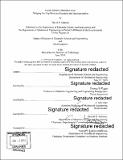Naval additive manufacturing : bridging the gap between research and implementation
Author(s)
Johnsen, David P.Nav. E.Massachusetts Institute of Technology.
Download1119389613-MIT.pdf (29.96Mb)
Alternative title
Naval AM : bridging the gap between research and implementation
Other Contributors
Massachusetts Institute of Technology. Department of Mechanical Engineering.
Advisor
Thomas W. Eagar.
Terms of use
Metadata
Show full item recordAbstract
Additive manufacturing (AM), commonly known as three-dimensional printing, presents numerous advantages over traditional production methods, including design-to-end-use process reduction and on-demand generation of needed parts. While some companies have recently been founded with AM as their focus, many established large organizations are striving to find ways that the technology facilitates strategy execution. With its manufacturing base and requisite supply infrastructure, the military branches pose a significant opportunity for AM implementation. In particular, the U.S. Navy's continual pursuit to enhance operational readiness and advance unit self-sustainability provides a ripe environment for AM. This research sought to advance the Navy's AM implementation initiatives through the identification of candidate applications, bridging the detected gap between ashore AM research developments and the cognizance of its front-line personnel. The resultant coordination of multiple exercises involving the Navy's operational units and field activities, culminating in two Naval AM Part-Identification Exercises, led to the discovery of over 600 AM applications that have established the Fleet's demand for AM and expedited the branch's adoption of the technology. While polymer and metal applications were identified, metallic components entail additional testing and analysis prior to shipboard use. Numerous Navy-wide efforts have stemmed from the exercises' findings, including affordability initiatives, technical data package developments, and a refined timeline for shipboard AM installation engagements. In addition, multiple avenues for the expansion of identified applications are recommended, leveraging the Fleet's existing methods of tracking material condition. An examination of the Navy's existing guidance and many of its leading AM organizations provides the context for the research efforts. Seeking to inform these key stakeholders of considerations that must be understood prior to widespread AM utilization, an evaluation of product quality using digitally-shared print files and shipboard material distribution analyses are incorporated, providing opportunities for future development.
Description
Thesis: Nav. E., Massachusetts Institute of Technology, Department of Mechanical Engineering, 2019 Thesis: S.M., Massachusetts Institute of Technology, Department of Mechanical Engineering, 2019 Cataloged from PDF version of thesis. Includes bibliographical references (pages 197-200).
Date issued
20192019
Department
Massachusetts Institute of Technology. Department of Mechanical EngineeringPublisher
Massachusetts Institute of Technology
Keywords
Mechanical Engineering.